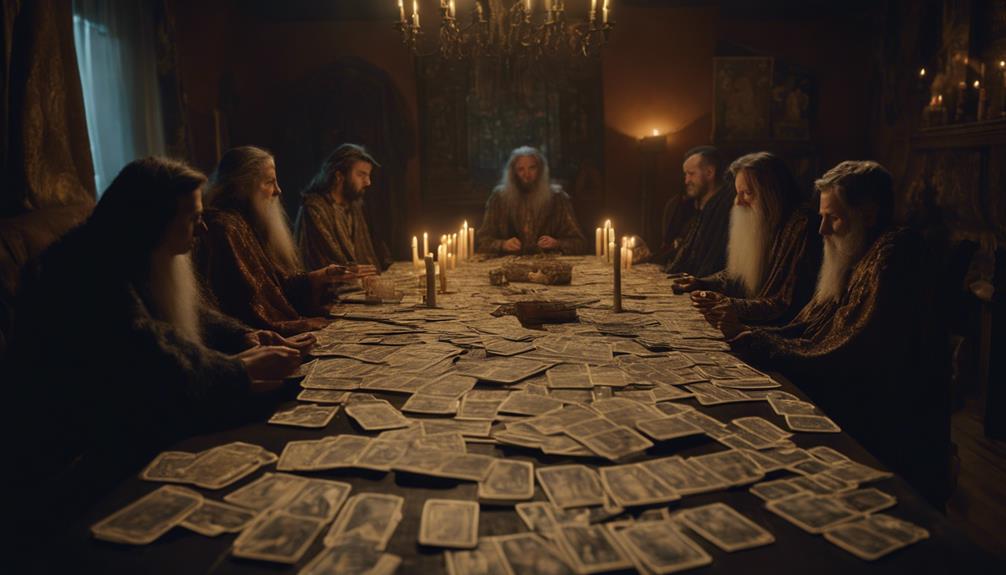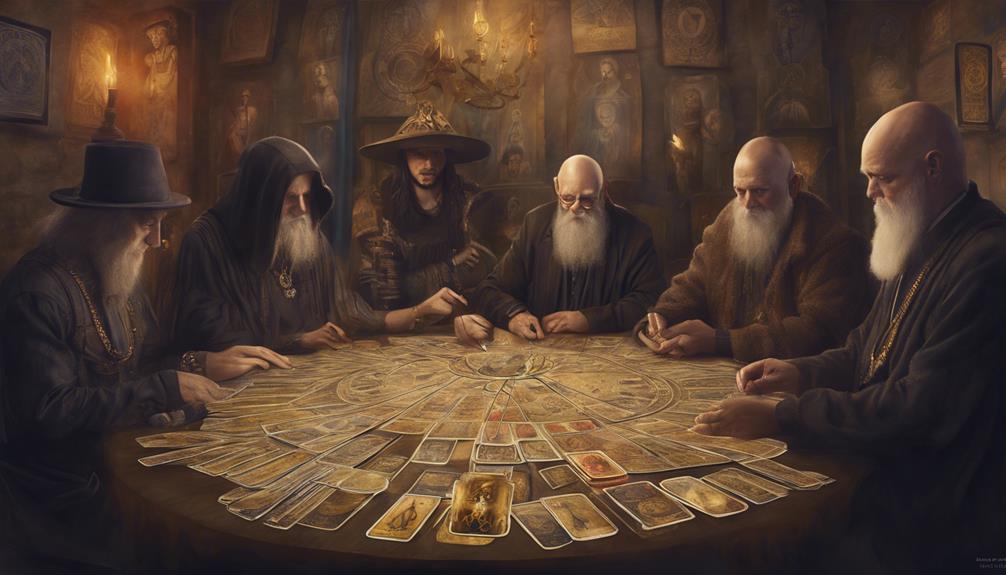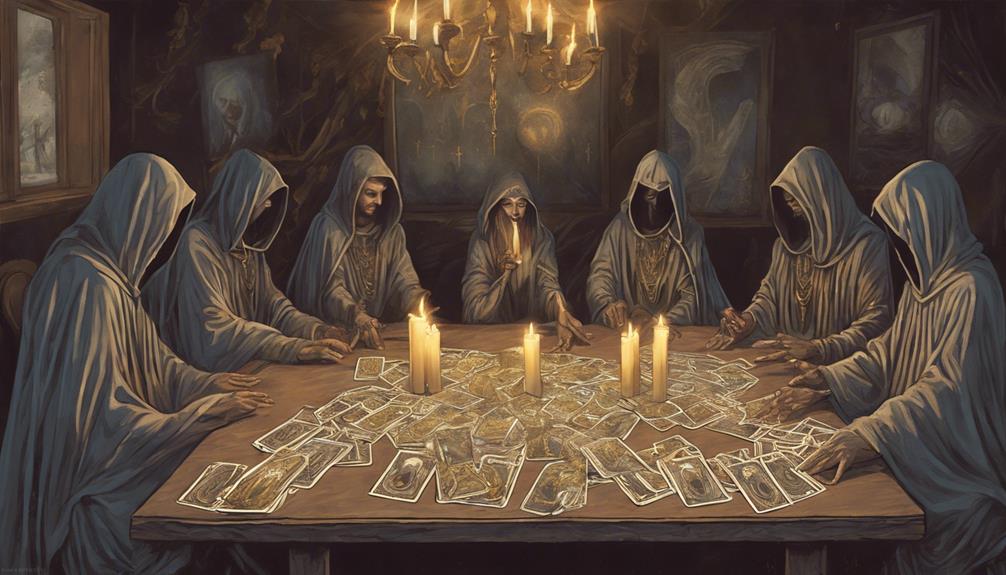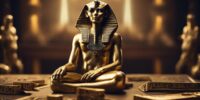How Golden Dawn Society Members Shaped Modern Tarot Practices

The Golden Dawn society, a secret occult organization founded in the late 19th century, had a significant influence on modern tarot practices. The society incorporated tarot cards into its rituals and teachings, attributing esoteric meanings to the cards beyond their traditional use for divination.
One of the key contributions of the Golden Dawn was the development of the tarot deck known as the Rider-Waite-Smith deck, created by artist Pamela Colman Smith under the guidance of Golden Dawn member Arthur Edward Waite. This deck, first published in 1909, introduced symbolic imagery and esoteric correspondences that have become standard in many modern tarot decks.
The Golden Dawn's emphasis on tarot as a tool for spiritual growth and self-discovery, rather than just fortune-telling, has had a lasting impact on how tarot is used and understood today. The society's teachings and practices continue to influence tarot readers and enthusiasts around the world, shaping the way tarot is interpreted and utilized in contemporary spiritual and mystical contexts.
Origins of the Golden Dawn Society
The origins of the Golden Dawn Society trace back to the late 19th century when a group of esoteric enthusiasts in England sought to explore the domains of mysticism and ritual magic. Founded in 1888, this society held deep historical significance in the world of occult practices. With its roots entwined in ancient mystical traditions, the Golden Dawn Society explored the mystical arts through secret rituals and ceremonies.
The society's occult origins paved the way for a resurgence of interest in esoteric knowledge, drawing individuals who sought to unravel the mysteries of the universe. Through their exploration of symbolism, astrology, and divination, members of the Golden Dawn Society developed a unique system that blended ancient wisdom with contemporary understanding.
The secret rituals conducted by the society weren't merely for show but held profound spiritual meaning for those involved. These rituals served as a gateway to deeper understanding and self-discovery, guiding members on a transformative journey towards enlightenment and personal growth.
Influence of Arthur Edward Waite
Arthur Edward Waite, a prominent member of the Golden Dawn Society, left a lasting impact on modern tarot practices through his creation of the Rider-Waite-Smith tarot deck.
This deck, known for its rich symbolic imagery and detailed illustrations, revolutionized the way tarot cards were perceived and used.
Waite's influence extended beyond the physical design of the deck, shaping the interpretation and understanding of tarot readings for generations to come.
Waite's Symbolic Imagery
Waite's Symbolic Imagery, deeply rooted in esoteric traditions, captivates readers with its intricate layers of meaning. His approach to symbolism interpretation and Tarot history evolution reshaped the way Tarot decks were perceived and utilized. Through his collaboration with artist Pamela Colman Smith, Waite infused each card with rich symbolism that drew upon various mystical traditions, creating a tapestry of interconnected meanings. Below is a table highlighting some of the key symbols found in the Rider-Waite-Smith Tarot deck, inviting readers to explore the depths of Waite's intricate designs:
| Symbol | Meaning |
|---|---|
| Sunflower | Vitality, warmth |
| Tower | Destruction, change |
| Moon | Intuition, mystery |
| Pentacle | Earthly matters |
| Owl | Wisdom, mystery |
These symbols, carefully chosen and interwoven, continue to inspire seekers on their journey towards self-discovery and enlightenment.
Tarot Deck Creation
Influencing the creation of numerous Tarot decks, Arthur Edward Waite's profound insights and mystical knowledge guided the intricate designs and symbolic richness of these divinatory tools. Waite's artistic influences are evident in the Rider-Waite-Smith deck, where he collaborated with artist Pamela Colman Smith to bring his visions to life.
The deck's revolutionary approach to tarot deck design, with detailed illustrations on each card, set a new standard for future decks. Waite's emphasis on symbolism and esoteric knowledge infused the cards with layers of meaning, appealing to both seasoned practitioners and newcomers to tarot.
Through his innovative interpretations and attention to detail, Waite laid the foundation for modern tarot deck creation, leaving a lasting legacy in the world of divination.
Aleister Crowley's Tarot Contributions

Aleister Crowley greatly influenced the world of tarot through his innovative contributions to the symbolism and interpretation of the cards. Crowley's legacy in the area of occult symbolism continues to captivate and intrigue tarot enthusiasts worldwide. Here are four key aspects of Aleister Crowley's tarot contributions that have left an indelible mark on modern tarot practices:
- Thoth Tarot Deck: Crowley collaborated with Lady Frieda Harris to create the Thoth Tarot deck, infusing it with rich esoteric symbolism and deep mystical meanings.
- Book of Thoth: Crowley's 'Book of Thoth' serves as a detailed guide to the Thoth Tarot deck, offering profound insights into the cards' interpretations and esoteric significance.
- Thelema Influence: Crowley's incorporation of Thelemic principles into his tarot work brought a fresh perspective to the cards, emphasizing individual will and spiritual evolution.
- Qabalistic Teachings: Crowley integrated Qabalistic teachings into his tarot interpretations, adding layers of mystical depth and esoteric wisdom to the cards. These elements combined to shape Crowley's enduring legacy in the world of tarot, inspiring countless practitioners to explore the deeper mysteries of the cards.
Esoteric Symbolism in Tarot Decks
Crowley's profound exploration of esoteric symbolism within tarot decks has greatly influenced the modern understanding and interpretation of the cards. His thorough investigation into alchemy, mysticism, and occult symbolism infused the tarot with layers of meaning, transcending its historical roots. Drawing from Tarot history and esoteric traditions, Crowley delved into the mystical significance of each card, imbuing them with a rich tapestry of symbols that speak to the subconscious mind.
Through Crowley's work, tarot decks became more than mere fortune-telling tools; they evolved into mirrors reflecting the complexities of the human experience. The fusion of alchemical principles and esoteric teachings within the cards opened a gateway to profound self-discovery and spiritual enlightenment. Each symbol carefully chosen, each color meticulously selected, all contributing to a language of the soul that transcends time and space.
In modern tarot practices, the legacy of Crowley's exploration lives on, inviting seekers to unravel the hidden truths woven into the fabric of each card, discovering the mysteries of the universe one draw at a time.
Golden Dawn's Impact on Tarot Interpretations

The Golden Dawn's influence on Tarot interpretations is profound, shaping the way symbolism is understood and integrated into readings. By incorporating esoteric elements into their practices, Golden Dawn members brought a deeper layer of meaning to the Tarot cards, influencing modern interpretations.
Their legacy continues to impact how Tarot readers approach and interpret the symbolism within the cards, reflecting a rich tapestry of esoteric influences.
Symbolism in Tarot
Symbolism in Tarot, heavily influenced by the Golden Dawn society members, continues to shape modern tarot practices with profound depth and significance. Delving into the intricate tapestry of meanings woven into the cards, one can uncover a world of insights waiting to be explored.
- Color associations, interpretation: The Golden Dawn brought attention to the significance of colors in tarot, linking them to emotions and energies.
- Numerology, archetypes: By incorporating numerology into tarot readings, the Golden Dawn members enhanced the depth of interpretation through the understanding of symbolic numbers.
- Elemental connections: The Golden Dawn's emphasis on the elements – earth, air, fire, and water – added layers of meaning to the cards, enriching interpretations.
- Astrological influences: Aligning tarot cards with astrological principles, as championed by the Golden Dawn, offers a deeper understanding of personality traits and life events.
Esoteric Influences
Influencing the depths of tarot interpretations, the Golden Dawn society's esoteric impacts have left an indelible mark on the practice, illuminating paths of profound insight and mystic understanding. Their influential teachings have infused tarot readings with layers of symbolism and hidden meanings, inviting practitioners to explore into the mystical practices of the cards.
Rituals and Practices of Society Members
Embracing ancient mysticism and esoteric knowledge, the modern Tarot practices of Golden Dawn Society members are imbued with intricate rituals and profound spiritual significance. These rituals serve as gateways to deeper understandings of the self and the universe, offering seekers a path to enlightenment and wisdom.
- Secret Ceremonies: Society members engage in mysterious and sacred rituals, shrouded in secrecy and steeped in tradition, to access hidden truths and mysteries.
- Mystical Teachings: Through the guidance of ancient mystical teachings, members explore the depths of the Tarot to reveal symbolic meanings and spiritual insights.
- Occult Practices: The utilization of occult practices within the Society's rituals allows members to tap into supernatural forces and explore the domains beyond the physical world.
- Spiritual Enlightenment: At the core of these practices lies the pursuit of spiritual enlightenment, where individuals seek higher consciousness and deeper connections with the divine.
Legacy of Golden Dawn on Modern Tarot

The profound influence of the Golden Dawn Society on modern Tarot practices is undeniable, shaping the very essence of how Tarot is understood and utilized in contemporary spiritual endeavors. The legacy of the Golden Dawn can be observed in various aspects of modern Tarot, from symbolism to interpretation, reflecting a fusion of ancient wisdom with innovative perspectives. Below is a visual representation of the impact of the Golden Dawn on modern Tarot practices:
| Legacy of Golden Dawn on Modern Tarot | Key Aspects | Influence |
|---|---|---|
| Tarot Symbolism | Synthesis of esoteric traditions | Deepened layers of meaning |
| Interpretation | Psychological insights | Expanded perspectives |
| Modern Practices | Integration of ritual practices | Enhanced spiritual connections |
| Evolution | Adaptation to contemporary contexts | Continued relevance |
| Innovative Approaches | Exploration of new symbolism | Pushing boundaries |
Through the Golden Dawn's teachings, modern Tarot has evolved into a versatile tool for spiritual growth and self-discovery, offering practitioners a rich tapestry of symbols and interpretations to explore.
Evolution of Tarot Spreads and Readings
A fascinating journey unfolds as Tarot spreads and readings evolve over time, weaving intricate patterns of insight and guidance for seekers.
- Spread Variations: Tarot spreads have diversified from traditional Celtic Cross layouts to more specialized spreads like the Relationship Spread or the Career Path Spread, offering tailored insights for specific life aspects.
- Interpretation Techniques: Modern readers have developed innovative interpretation techniques, incorporating Jungian psychology, elemental correspondences, and intuitive storytelling to deepen the reading experience.
- Historical Context: Understanding the origins of Tarot in medieval Europe and its evolution through Renaissance symbolism sheds light on the rich tapestry of meanings embedded in each card.
- Cultural Significance: Tarot's integration into popular culture, from art to literature, reflects its enduring relevance and adaptability in an ever-changing world.
As Tarot continues to captivate hearts and minds, its evolution mirrors the dynamic nature of human existence, offering a timeless tool for introspection and empowerment.
Frequently Asked Questions
How Did the Golden Dawn Society's Teachings on Tarot Impact Other Areas of Western Esotericism?
The Golden Dawn Society's teachings on tarot impacted western esotericism by enriching tarot symbolism and influencing esoteric connections. These developments led to a deeper understanding of mystical practices and expanded spiritual horizons within the esoteric community.
Were There Any Notable Disagreements or Controversies Within the Golden Dawn Society Regarding Tarot Practices?
Within the Golden Dawn Society, notable disagreements arose regarding the interpretation of tarot cards. Controversies often stemmed from differing views on symbolism and esoteric meanings. These conflicts influenced the evolution of tarot practices within the society.
How Did the Golden Dawn Society View the Use of Tarot for Divination Versus Spiritual Growth and Self-Discovery?
The Golden Dawn Society valued tarot for both divination practices and spiritual growth. Members saw the cards as tools for revealing inner wisdom and connecting with higher worlds. They believed in the power of tarot for self-discovery and enlightenment.
Did the Golden Dawn Society Have Any Specific Guidelines or Recommendations for Creating or Choosing a Tarot Deck?
When creating or choosing tarot decks, the Golden Dawn Society offered specific guidelines and recommendations. They emphasized symbolism, esoteric meanings, and alignment with the practitioner's spiritual journey. These considerations were pivotal in shaping modern tarot practices.
How Have Modern Tarot Practitioners and Scholars Critiqued or Reinterpreted the Teachings of the Golden Dawn Society in Relation to Tarot Practices?
Modern tarot practitioners and scholars often critique and reinterpret Golden Dawn Society teachings in relation to tarot practices. They scrutinize for relevance, adaptability, and accuracy, shaping new methodologies while honoring the society's foundational contributions.











